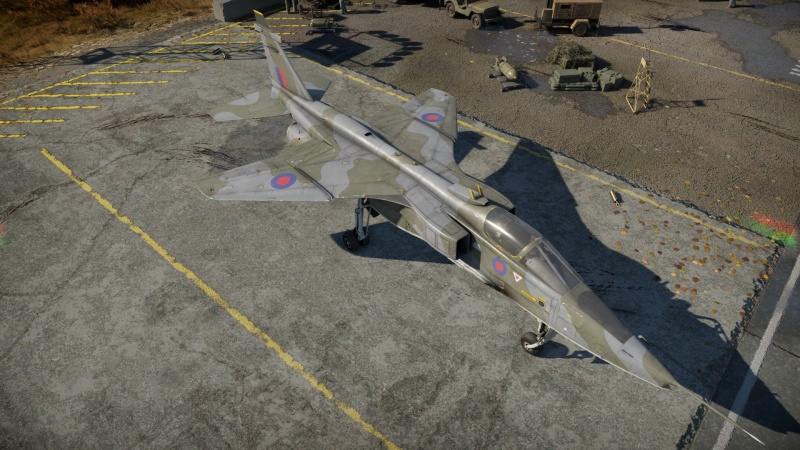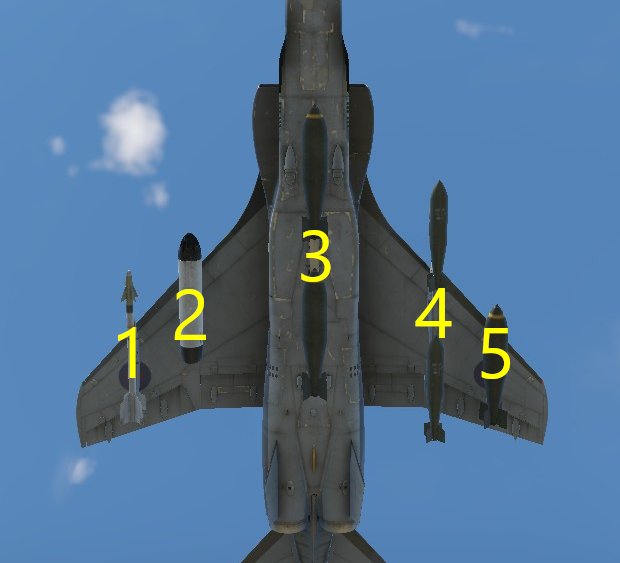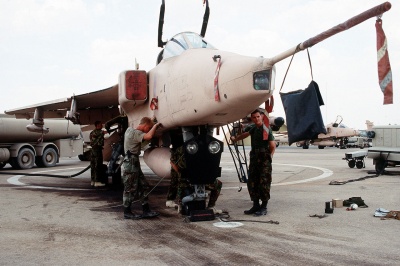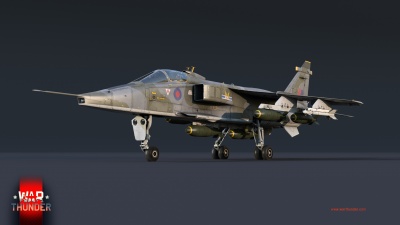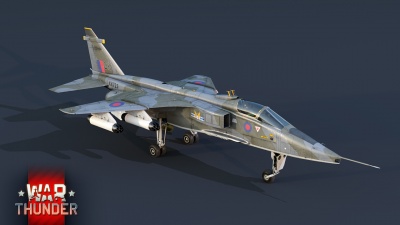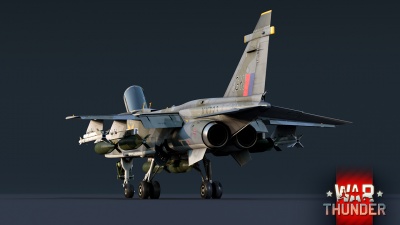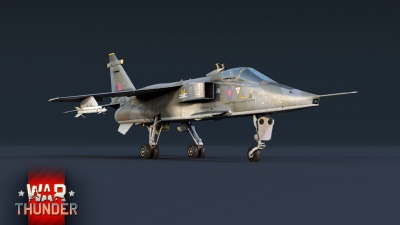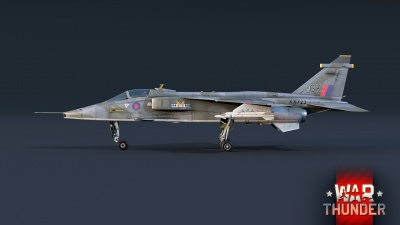Difference between revisions of "Jaguar GR.1"
CobraKingII (talk | contribs) (→History) (Tag: Visual edit) |
(→Suspended armament: Updated) |
||
| (34 intermediate revisions by 11 users not shown) | |||
| Line 1: | Line 1: | ||
{{About | {{About | ||
| − | | about = British | + | | about = British strike aircraft '''{{PAGENAME}}''' |
| − | | usage = | + | | usage = other versions |
| − | | link = Jaguar | + | | link = Jaguar (Family) |
}} | }} | ||
{{Specs-Card | {{Specs-Card | ||
| Line 11: | Line 11: | ||
== Description == | == Description == | ||
<!-- ''In the description, the first part should be about the history of and the creation and combat usage of the aircraft, as well as its key features. In the second part, tell the reader about the aircraft in the game. Insert a screenshot of the vehicle, so that if the novice player does not remember the vehicle by name, he will immediately understand what kind of vehicle the article is talking about.'' --> | <!-- ''In the description, the first part should be about the history of and the creation and combat usage of the aircraft, as well as its key features. In the second part, tell the reader about the aircraft in the game. Insert a screenshot of the vehicle, so that if the novice player does not remember the vehicle by name, he will immediately understand what kind of vehicle the article is talking about.'' --> | ||
| − | The '''{{Specs|name}}''' | + | The '''{{Specs|name}}''' was developed from the SEPECAT Jaguar, a joint project between Britain and France in the 1960s and 1970s. The Jaguar was originally designed as a trainer and light attack aircraft but later evolved into a supersonic strike aircraft with precise strike capability. It entered service with the Royal Air Force in 1974. It was also exported to India, Oman, Ecuador, and Nigeria. The Jaguar saw combat in several conflicts, such as the Gulf War, the Iraq War, and the Kargil War. It remained in service with the RAF until 2007, when it was replaced by the Eurofighter Typhoon. |
| + | |||
| + | The {{Specs|name}} was introduced in [[Update "Raining Fire"]]. It is fit with afterburning engines and totes an incredibly heavy air-to-ground payload, with full ballistics computer capability to match, though its flight performance does not lend well to air-to-air combat. It's also worth noting that the aircraft lacks any kind of countermeasures. This means that players need to be strategic and cautious when using this aircraft. Nonetheless, its payload options make it a worthwhile jet for ground attack missions. | ||
== General info == | == General info == | ||
| Line 29: | Line 31: | ||
|- | |- | ||
! Stock | ! Stock | ||
| − | | 1, | + | | 1,464 || 1,453 || rowspan="2" | {{Specs|ceiling}} || 31.8 || 32.4 || 74.6 || 67.7 || rowspan="2" | 850 |
|- | |- | ||
! Upgraded | ! Upgraded | ||
| − | |1, | + | | 1,524 || 1,490 || 28.6 || 30.0 || 108.7 || 90.0 |
|- | |- | ||
|} | |} | ||
| Line 58: | Line 60: | ||
! Combat !! Take-off !! Landing !! + !! - | ! Combat !! Take-off !! Landing !! + !! - | ||
|- | |- | ||
| − | | {{Specs|destruction|body}} || {{Specs|destruction|gear}} || | + | | 1,273 <!-- {{Specs|destruction|body}} --> || {{Specs|destruction|gear}} || 926 || 525 || 410 || ~12 || ~6 |
|- | |- | ||
|} | |} | ||
| Line 68: | Line 70: | ||
! Ailerons !! Rudder !! Elevators !! Radiator | ! Ailerons !! Rudder !! Elevators !! Radiator | ||
|- | |- | ||
| − | | < | + | | < 585 || < 600 || < 649 || N/A |
|- | |- | ||
|} | |} | ||
| Line 76: | Line 78: | ||
|- | |- | ||
! colspan="3" | Engine | ! colspan="3" | Engine | ||
| − | ! colspan=" | + | ! colspan="6" | Aircraft mass |
|- | |- | ||
! colspan="2" | Engine name || Number | ! colspan="2" | Engine name || Number | ||
| − | ! colspan=" | + | ! colspan="3" | {{Annotation|Basic mass|Mass of the aircraft with pilot and engine oil, but no fuel or weapons load}} || colspan="3" | Wing loading (full fuel) |
|- | |- | ||
| colspan="2" | Rolls-Royce Turbomeca Limited Adour Mk.102 || 2 | | colspan="2" | Rolls-Royce Turbomeca Limited Adour Mk.102 || 2 | ||
| − | | colspan=" | + | | colspan="3" | 7,616 kg || colspan="3" | 453 kg/m<sup>2</sup> |
|- | |- | ||
! colspan="3" | Engine characteristics | ! colspan="3" | Engine characteristics | ||
| − | ! colspan=" | + | ! colspan="5" | Mass with fuel (no weapons load) || rowspan="2" | Max Takeoff<br>Weight |
|- | |- | ||
! Weight (each) || colspan="2" | Type | ! Weight (each) || colspan="2" | Type | ||
| − | ! | + | ! 15m fuel || 20m fuel || 30m fuel || 45m fuel || 53m fuel |
|- | |- | ||
| 709 kg || colspan="2" | Afterburning low-bypass turbofan | | 709 kg || colspan="2" | Afterburning low-bypass turbofan | ||
| − | | 8, | + | | 8,592 kg || 8,838 kg || 9,448 kg || 10,365 kg || 10,869 kg || 13,500 kg |
|- | |- | ||
| − | ! colspan="3" | {{Annotation|Maximum engine thrust @ 0 m (RB / SB)|The maximum thrust produced by each engine, while mounted in the aircraft. NOTE: Thrust varies significantly depending on speed & altitude.}} | + | ! colspan="3" | {{Annotation|Maximum engine thrust @ 0 m (RB/SB)|The maximum thrust produced by each engine, while mounted in the aircraft. NOTE: Thrust varies significantly depending on speed & altitude.}} |
| − | ! colspan=" | + | ! colspan="6" | Thrust to weight ratio @ 0 m (WEP) |
|- | |- | ||
! Condition || 100% || WEP | ! Condition || 100% || WEP | ||
| − | ! | + | ! 15m fuel || 20m fuel || 30m fuel || 45m fuel || 53m fuel || MTOW |
|- | |- | ||
| ''Stationary'' || 1,998 kgf || 3,094 kgf | | ''Stationary'' || 1,998 kgf || 3,094 kgf | ||
| − | | 0.72 || 0. | + | | 0.72 || 0.70 || 0.65 || 0.60 || 0.57 || 0.46 |
|- | |- | ||
| − | | ''Optimal'' || 2,242 kgf<br | + | | ''Optimal'' || 2,242 kgf<br>(200 km/h) || 3,307 kgf<br>(200 km/h) |
| − | | 0.77 || 0. | + | | 0.77 || 0.75 || 0.70 || 0.64 || 0.61 || 0.49 |
|- | |- | ||
|} | |} | ||
| Line 110: | Line 112: | ||
{{Specs-Avia-Armour}} | {{Specs-Avia-Armour}} | ||
<!-- ''Examine the survivability of the aircraft. Note how vulnerable the structure is and how secure the pilot is, whether the fuel tanks are armoured, etc. Describe the armour, if there is any, and also mention the vulnerability of other critical aircraft systems.'' --> | <!-- ''Examine the survivability of the aircraft. Note how vulnerable the structure is and how secure the pilot is, whether the fuel tanks are armoured, etc. Describe the armour, if there is any, and also mention the vulnerability of other critical aircraft systems.'' --> | ||
| − | The Jaguar GR.1 has no armour plating or armoured glass. The entire | + | The Jaguar GR.1 has no armour plating or armoured glass. The entire wingspan of the Jaguar GR.1 is composed of fuel tanks, along with most of the upper fuselage, with flight controls being exposed in the "spine" of the aircraft, making it very vulnerable to damage received anywhere along the mid-section or wings of the aircraft. |
| + | |||
| + | The two jet's engines take up a small amount of room in the very rear of the fuselage and the Jaguar's elevators are separated from each other, allowing the aircraft to potentially survive a glancing blow to its tail section. The Jaguar's nosecone is also devoid of any avionics, and the pilot is seated relatively far back, causing strikes there to deal little damage. | ||
| + | |||
| + | The Jaguar GR.1 is fit with an AN/APR-25 radar warning receiver inside the vertical stabiliser, providing the pilot with advanced warning when being tracked by a radar system, such as an advanced anti-air emplacement or fighter aircraft. | ||
=== Modifications and economy === | === Modifications and economy === | ||
| Line 117: | Line 123: | ||
== Armaments == | == Armaments == | ||
{{Specs-Avia-Armaments}} | {{Specs-Avia-Armaments}} | ||
| + | {| class="wikitable" style="text-align:center" | ||
| + | |- | ||
| + | ! colspan="4" | [[Ballistic Computer]] | ||
| + | |- | ||
| + | ! CCIP (Guns) !! CCIP (Rockets) !! CCIP (Bombs) !! CCRP (Bombs) | ||
| + | |- | ||
| + | | {{Tick}} || {{Tick}} || {{Tick}} || {{Tick}} | ||
| + | |- | ||
| + | |} | ||
=== Offensive armament === | === Offensive armament === | ||
{{Specs-Avia-Offensive}} | {{Specs-Avia-Offensive}} | ||
| Line 126: | Line 141: | ||
* 2 x 30 mm ADEN Mk.4 cannons, belly-mounted (150 rpg = 300 total) | * 2 x 30 mm ADEN Mk.4 cannons, belly-mounted (150 rpg = 300 total) | ||
| + | The Jaguar's ADEN Mk.4s are excellent against air targets, capable of dealing critical damage even with glancing blows and otherwise outright destroying aircraft with a single hit, although their ballistics are only average compared to the Jaguar's opponents and the cannons are not particularly lethal against ground targets with any amount of armour. | ||
| + | |||
| + | As the ADEN Mk.4 is typically only used in air-to-air engagements, it may be advisible to steer away from the ''Ground targets'' belt, and instead use one of the other three to increase the number of high-explosive shells in the belt. | ||
=== Suspended armament === | === Suspended armament === | ||
{{Specs-Avia-Suspended}} | {{Specs-Avia-Suspended}} | ||
<!-- ''Describe the aircraft's suspended armament: additional cannons under the wings, bombs, rockets and torpedoes. This section is especially important for bombers and attackers. If there is no suspended weaponry remove this subsection.'' --> | <!-- ''Describe the aircraft's suspended armament: additional cannons under the wings, bombs, rockets and torpedoes. This section is especially important for bombers and attackers. If there is no suspended weaponry remove this subsection.'' --> | ||
| − | |||
The '''''{{PAGENAME}}''''' can be outfitted with the following ordnance: | The '''''{{PAGENAME}}''''' can be outfitted with the following ordnance: | ||
| − | * | + | {| class="wikitable" style="text-align:center" width="100%" |
| + | |- | ||
| + | ! !! width="9%" | 1 !! width="9%" | 2 !! width="9%" | 3 !! width="9%" | 4 !! width="9%" | 5 | ||
| + | | rowspan="7" width="25%" | <div class="ttx-image">[[File:Hardpoints_{{PAGENAME}}.png]]</div> | ||
| + | |- | ||
| + | ! [[Mk.M2 (540 lb)|540 lb Mk.M2]] bombs | ||
| + | | 1 || 2 || 2 || 2 || 1 | ||
| + | |- | ||
| + | ! [[H.E. M.C. Mk.13 (1,000 lb)|1,000 lb H.E. M.C. Mk.13]] bombs | ||
| + | | 1 || 2 || 2 || 2 || 1 | ||
| + | |- | ||
| + | ! [[H.E. M.C. Mk.13 No.117 (1,000 lb)|1,000 lb H.E. M.C. Mk.13 No.117]] bombs | ||
| + | | 1 || 2 || 2 || 2 || 1 | ||
| + | |- | ||
| + | ! [[CRV7 M247]] rockets | ||
| + | | 19 || 19 || || 19 || 19 | ||
| + | |- | ||
| + | ! [[AIM-9G Sidewinder]] missiles | ||
| + | | 1 || || || || 1 | ||
| + | |- | ||
| + | ! 264 gal drop tanks | ||
| + | | || 1 || 1 || 1 || | ||
| + | |- | ||
| + | |} | ||
| + | |||
| + | {{Navigation-Start|Default weapon presets}} | ||
| + | {{Navigation-First-Simple-Line}} | ||
| + | * 3 x 264 gal drop tanks | ||
| + | * 8 x 540 lb Mk.M2 bombs (4,320 lb total) | ||
| + | * 8 x 1,000 lb H.E. M.C. Mk.13 bombs (8,000 lb total) | ||
| + | * 8 x 1,000 lb H.E. M.C. Mk.13 No.117 bombs (8,000 lb total) | ||
* 2 x AIM-9G Sidewinder missiles | * 2 x AIM-9G Sidewinder missiles | ||
* 76 x CRV7 M247 rockets | * 76 x CRV7 M247 rockets | ||
| − | + | {{Navigation-End}} | |
| − | |||
| − | |||
| − | |||
| − | |||
== Usage in battles == | == Usage in battles == | ||
<!-- ''Describe the tactics of playing in the aircraft, the features of using aircraft in a team and advice on tactics. Refrain from creating a "guide" - do not impose a single point of view, but instead, give the reader food for thought. Examine the most dangerous enemies and give recommendations on fighting them. If necessary, note the specifics of the game in different modes (AB, RB, SB).'' --> | <!-- ''Describe the tactics of playing in the aircraft, the features of using aircraft in a team and advice on tactics. Refrain from creating a "guide" - do not impose a single point of view, but instead, give the reader food for thought. Examine the most dangerous enemies and give recommendations on fighting them. If necessary, note the specifics of the game in different modes (AB, RB, SB).'' --> | ||
| − | As a strike aircraft, the Jaguar is | + | As a strike aircraft, the Jaguar GR.1 is well-suited to engaging ground targets with its ability to carry up to eight 1,000 lb bombs and access to a complete ballistics computer allowing it to shine in this role, particularly in ground battles. The aircraft's moderately high speed and good agility allow it to easily manoeuvre near terrain while providing close air support, although the aircraft bleeds considerable energy in turns making it highly unsuitable for air-to-air combat. |
| + | |||
| + | The Jaguar GR.1 includes a pair of internal ADEN Mk.4 30 mm cannons for self-defense against aircraft, and can additionally be fitted with a pair of AIM-9G Sidewinder missiles, at the expense of two bombs, allowing the Jaguar to pose a threat to enemy fighters in its airspace, and making it particularly lethal against distracted aircraft, although the Jaguar's poor energy retention and top speed only barely cresting mach 1.0 make it vulnerable to the many dedicated fighters it can face in battle. Where possible, the Jaguar should be employed in combat with supporting allied aircraft, particularly in air battles. | ||
| − | + | The aircraft features a drag chute, air brakes, and an arresting hook, as well as large landing flaps, making landings with the Jaguar simple and quick. Given the Jaguar's high speed (when not manoeuvring) contrasted with its mediocre dogfight capability and the ADEN's relatively poor performance in ground strike, the Jaguar is best when it relies on its secondary weapons, returning to the airfield once they are expended rather than remaining in combat when it is down to only its 30 mm cannons. | |
'''Enemies worth noting:''' | '''Enemies worth noting:''' | ||
| − | + | [[MiG-21 (Family)]] - As a western aircraft, the Jaguar GR.1 often faces operators of the MiG-21's many variants. The [[MiG-21F-13]] and [[J-7II]] are dangerous opponents, with their 30 mm cannons easily destroying the Jaguar in a single hit, although their missiles are not typically a threat; they are the equivalent of AIM-9Bs, and can lose track if the Jaguar is further away or turning. Ideally, these planes will engage the Jaguar when it is distracted or at lower speeds. The [[MiG-21SMT]] and [[MiG-21MF (Germany)|MF]] variants of the jet are much more serious threats, featuring higher performance and the deadly [[R-60]] missiles, with the Jaguar GR.1's lack of countermeasures leaving it seriously vulnerable to these aircraft. | |
| − | |||
| − | As a | ||
| − | |||
| − | |||
| − | |||
| − | |||
| − | ''' | + | [[F-4 Phantom II (Family)]] - The Jaguar GR.1 typically only encounters the [[F-4C Phantom II]] variant in realistic battles which, although suffering from the same dogfighting deficiency as the Jaguar, carries a much more lethal missile payload as well as an air-to-air radar. The F-4C's [[AIM-7D Sparrow]]s are very potent against the Jaguar GR.1 as, although it has a radar warning receiver to alert the pilot of the threat, the Jaguar's lack of chaff gives it little response to an incoming missile, and the F-4C's GAU-4 20 mm cannon and AIM-9E Sidewinders are a notable threat to the Jaguar at closer ranges. |
| − | The | + | [[F-5C]] - The premium F-5C Skoshi Tiger is perhaps the biggest threat the Jaguar GR.1 will face on the battlefield. With a noticably superior engine, considerably better dogfight characteristics, and a full countermeasures package, the F-5C is capable of out-manoeuvring the Jaguar at every turn, and its flares make the Jaguar's AIM-9G Sidewinders almost entirely useless against a Skoshi Tiger pilot aware of their launch. To make matters worse, the F-5C's incredibly durable airframe means that the Jaguar is not guaranteed a victory even should it successfully hit the aircraft. |
=== Pros and cons === | === Pros and cons === | ||
| Line 167: | Line 206: | ||
'''Pros:''' | '''Pros:''' | ||
| − | * | + | * Access to AIM-9G Sidewinders, which have a reasonably long range and manoeuvrability. |
| − | * | + | * Reasonably agile, particularly compared to heavier fighters like the [[F-4C Phantom II]], alongside a good roll rate. |
| − | + | * Heavy air-to-ground loadouts, able to carry up to eight 1,000 lb bombs. | |
| − | * | + | * Equipped with a full ballistics computer for its cannon, rockets, and bombs. |
| − | * Armed with | + | * Armed with powerful ADEN Mk.4 30 mm cannons for anti-air usage |
| − | * | + | * Fitted with a radar warning receiver |
| − | * | + | * Comfortable to land, thanks to large landing gear, airbrakes, a drogue chute, and large landing flaps |
| + | * Equipped with [[HUD#410SUM1|Head-Up Display]] in the cockpit, which displays a large variety of flight information and has full integration with weapon systems. | ||
'''Cons:''' | '''Cons:''' | ||
| − | * Mediocre speed | + | * Mediocre top speed, only barely capable of crossing mach 1. |
| − | * | + | * Middling climb rate and acceleration, with poor energy retention. |
| − | * | + | * Only able to cary two AIM-9G Sidewinders. |
| − | * | + | * Does not come equipped with any kind of radar, leaving it unable to use radar-homing missiles. |
| − | * | + | * Incredibly heavy when loaded with bombs. |
| + | * Does not carry any sort of countermeasures, leaving it susceptible to AA missiles. | ||
== History == | == History == | ||
<!-- ''Describe the history of the creation and combat usage of the aircraft in more detail than in the introduction. If the historical reference turns out to be too long, take it to a separate article, taking a link to the article about the vehicle and adding a block "/History" (example: <nowiki>https://wiki.warthunder.com/(Vehicle-name)/History</nowiki>) and add a link to it here using the <code>main</code> template. Be sure to reference text and sources by using <code><nowiki><ref></ref></nowiki></code>, as well as adding them at the end of the article with <code><nowiki><references /></nowiki></code>. This section may also include the vehicle's dev blog entry (if applicable) and the in-game encyclopedia description (under <code><nowiki>=== In-game description ===</nowiki></code>, also if applicable).'' --> | <!-- ''Describe the history of the creation and combat usage of the aircraft in more detail than in the introduction. If the historical reference turns out to be too long, take it to a separate article, taking a link to the article about the vehicle and adding a block "/History" (example: <nowiki>https://wiki.warthunder.com/(Vehicle-name)/History</nowiki>) and add a link to it here using the <code>main</code> template. Be sure to reference text and sources by using <code><nowiki><ref></ref></nowiki></code>, as well as adding them at the end of the article with <code><nowiki><references /></nowiki></code>. This section may also include the vehicle's dev blog entry (if applicable) and the in-game encyclopedia description (under <code><nowiki>=== In-game description ===</nowiki></code>, also if applicable).'' --> | ||
| − | The Jaguar was a joint program between the British and French to develop a cheap subsonic trainer and light attack aircraft. The British and French bought a total of 403 aircraft with Britain receiving 203 of the aircraft. Other exports include to the Indian Air force (160 total aircraft ordered ), The Royal Air force of Oman (26 total aircraft ordered), The Ecuadorian Air force (12 total aircraft ordered) and the air force of Nigeria (18 total aircraft ordered). The Jaguar was used in several military conflicts in countries such as: Mauritania, Chad, Iraq, Bosnia, Pakistan and The Chenepa war but most notably it saw service in the 1990 Gulf War during Operation Desert Storm, where it was used to destroy Iraqi artillery and missile positions. During the Bosnian bombing campaign of 1995 Jaguars of the 41 squadron carried out the first raids in Europe since the second world war. During the Bosnian airstrikes jaguars were fitted with laser designators and would laze Bosnian-Serb forces for RAF Harriers to strike. These re-fitted more modern Jaguars were re-designated as SEPECAT Jaguar GR.1 B. | + | [[File:Jaguar GR.1 in the Gulf.jpg|thumb|400px|right|British and U.S. ground crew members refuel a Royal Air Force Jaguar GR.1 during the Gulf War.]] |
| + | The SEPECAT Jaguar was a joint program between the British and French to develop a cheap subsonic trainer and light attack aircraft. The British and French bought a total of 403 aircraft with Britain receiving 203 of the aircraft. Other exports include to the Indian Air force (160 total aircraft ordered ), The Royal Air force of Oman (26 total aircraft ordered), The Ecuadorian Air force (12 total aircraft ordered) and the air force of Nigeria (18 total aircraft ordered). The Jaguar was used in several military conflicts in countries such as: Mauritania, Chad, Iraq, Bosnia, Pakistan and The Chenepa war but most notably it saw service in the 1990 Gulf War during Operation Desert Storm, where it was used to destroy Iraqi artillery and missile positions. During the Bosnian bombing campaign of 1995 Jaguars of the 41 squadron carried out the first raids in Europe since the second world war. During the Bosnian airstrikes jaguars were fitted with laser designators and would laze Bosnian-Serb forces for RAF Harriers to strike. These re-fitted more modern Jaguars were re-designated as SEPECAT Jaguar GR.1 B. | ||
===[[wt:en/news/6841-development-sepecat-jaguar-raining-fire-en|Devblog]]=== | ===[[wt:en/news/6841-development-sepecat-jaguar-raining-fire-en|Devblog]]=== | ||
| − | In the early | + | In the early 1960's, both Great Britain and France were looking into procuring a new jet trainer for their respective air forces. Despite differences in specifications and requirements, the two nations were united in their pursuit for such a new aircraft, thus leading to an agreement being signed in 1965 which would kick off development of what would eventually become the Jaguar. |
| − | The Jaguar was being developed under a specially formed consortium of British and French aviation companies, namely Breguet and BAC, called SEPECAT (you can look up what the acronym stands for on your own - we promise you | + | The Jaguar was being developed under a specially formed consortium of British and French aviation companies, namely Breguet and BAC, called SEPECAT (you can look up what the acronym stands for on your own - we promise you won't be disappointed though). Continuing with the theme of joint projects, Rolls-Royce and Turbomeca also joined forces to develop a new turbofan engine - the Adour - for the new aircraft. |
| − | The first of eight prototypes of the Jaguar successfully conducted its maiden flight in September of 1968. Following the conclusion of further testing, the Jaguar went into production in two major variants - the Jaguar A being the modification used by the French Air Force and the Jaguar S (Jaguar GR.1) being the variant employed by the RAF. Both variants of the machine entered production in the early | + | The first of eight prototypes of the Jaguar successfully conducted its maiden flight in September of 1968. Following the conclusion of further testing, the Jaguar went into production in two major variants - the Jaguar A being the modification used by the French Air Force and the Jaguar S (Jaguar GR.1) being the variant employed by the RAF. Both variants of the machine entered production in the early 1970's, with the first production models being delivered in 1973/'74. |
| + | |||
| + | The Jaguar primarily served with France and Great Britain, most notably distinguishing itself in action during the Gulf War of the 1990's. However, Ecuador, Nigeria and Oman also operated modifications of the Jaguar, while India still operates the Jaguar to this day. In total over 540 SEPECAT Jaguars were built. | ||
| − | |||
== Media == | == Media == | ||
<!-- ''Excellent additions to the article would be video guides, screenshots from the game, and photos.'' --> | <!-- ''Excellent additions to the article would be video guides, screenshots from the game, and photos.'' --> | ||
| − | + | ||
| + | ;Skins | ||
| + | |||
| + | * [https://live.warthunder.com/feed/camouflages/?vehicle=jaguar_gr1 Skins and camouflages for the {{PAGENAME}} from live.warthunder.com.] | ||
| + | |||
| + | ;Images | ||
| + | <gallery mode="packed" caption="Jaguar GR.1 Devblog Images" heights="150"> | ||
| + | File:Jaguar GR.1 WTWallpaper 001.jpg| | ||
| + | File:Jaguar GR.1 WTWallpaper 002.jpg| | ||
| + | File:Jaguar GR.1 WTWallpaper 003.jpg| | ||
| + | File:Jaguar GR.1 WTWallpaper 004.jpg| | ||
| + | File:Jaguar GR.1 WTWallpaper 005.jpg| | ||
| + | </gallery> | ||
== See also == | == See also == | ||
| Line 204: | Line 259: | ||
* ''links to approximate analogues of other nations and research trees.'' --> | * ''links to approximate analogues of other nations and research trees.'' --> | ||
| − | * [[Jaguar A]] | + | * [[Jaguar GR.1A]] |
| + | * [[Jaguar A]] (France) | ||
| + | * Japanese-developed aircraft inspired by the SEPECAT Jaguar | ||
| + | ** [[F-1]] | ||
| + | ** [[T-2]] | ||
== External links == | == External links == | ||
<!-- ''Paste links to sources and external resources, such as:'' | <!-- ''Paste links to sources and external resources, such as:'' | ||
* ''topic on the official game forum;'' | * ''topic on the official game forum;'' | ||
| − | |||
* ''other literature.'' --> | * ''other literature.'' --> | ||
* [[wt:en/news/6841-development-sepecat-jaguar-raining-fire-en|[Devblog] SEPECAT Jaguar: Raining Fire]] | * [[wt:en/news/6841-development-sepecat-jaguar-raining-fire-en|[Devblog] SEPECAT Jaguar: Raining Fire]] | ||
| + | * [https://forum.warthunder.com/index.php?/topic/497250-jaguar-gr1/ Official data sheet - more details about the performance] | ||
{{AirManufacturer SEPECAT}} | {{AirManufacturer SEPECAT}} | ||
{{Britain jet aircraft}} | {{Britain jet aircraft}} | ||
Latest revision as of 20:56, 20 June 2024
| This page is about the British strike aircraft Jaguar GR.1. For other versions, see Jaguar (Family). |
Contents
Description
The Jaguar GR.1 was developed from the SEPECAT Jaguar, a joint project between Britain and France in the 1960s and 1970s. The Jaguar was originally designed as a trainer and light attack aircraft but later evolved into a supersonic strike aircraft with precise strike capability. It entered service with the Royal Air Force in 1974. It was also exported to India, Oman, Ecuador, and Nigeria. The Jaguar saw combat in several conflicts, such as the Gulf War, the Iraq War, and the Kargil War. It remained in service with the RAF until 2007, when it was replaced by the Eurofighter Typhoon.
The Jaguar GR.1 was introduced in Update "Raining Fire". It is fit with afterburning engines and totes an incredibly heavy air-to-ground payload, with full ballistics computer capability to match, though its flight performance does not lend well to air-to-air combat. It's also worth noting that the aircraft lacks any kind of countermeasures. This means that players need to be strategic and cautious when using this aircraft. Nonetheless, its payload options make it a worthwhile jet for ground attack missions.
General info
Flight performance
| Characteristics | Max Speed (km/h at 10,668 m) |
Max altitude (metres) |
Turn time (seconds) |
Rate of climb (metres/second) |
Take-off run (metres) | |||
|---|---|---|---|---|---|---|---|---|
| AB | RB | AB | RB | AB | RB | |||
| Stock | 1,464 | 1,453 | 13716 | 31.8 | 32.4 | 74.6 | 67.7 | 850 |
| Upgraded | 1,524 | 1,490 | 28.6 | 30.0 | 108.7 | 90.0 | ||
Details
| Features | |||||
|---|---|---|---|---|---|
| Combat flaps | Take-off flaps | Landing flaps | Air brakes | Arrestor gear | Drogue chute |
| ✓ | ✓ | ✓ | ✓ | ✓ | ✓ |
| Limits | ||||||
|---|---|---|---|---|---|---|
| Wings (km/h) | Gear (km/h) | Flaps (km/h) | Max Static G | |||
| Combat | Take-off | Landing | + | - | ||
| 1,273 | 481 | 926 | 525 | 410 | ~12 | ~6 |
| Optimal velocities (km/h) | |||
|---|---|---|---|
| Ailerons | Rudder | Elevators | Radiator |
| < 585 | < 600 | < 649 | N/A |
Engine performance
| Engine | Aircraft mass | |||||||
|---|---|---|---|---|---|---|---|---|
| Engine name | Number | Basic mass | Wing loading (full fuel) | |||||
| Rolls-Royce Turbomeca Limited Adour Mk.102 | 2 | 7,616 kg | 453 kg/m2 | |||||
| Engine characteristics | Mass with fuel (no weapons load) | Max Takeoff Weight | ||||||
| Weight (each) | Type | 15m fuel | 20m fuel | 30m fuel | 45m fuel | 53m fuel | ||
| 709 kg | Afterburning low-bypass turbofan | 8,592 kg | 8,838 kg | 9,448 kg | 10,365 kg | 10,869 kg | 13,500 kg | |
| Maximum engine thrust @ 0 m (RB/SB) | Thrust to weight ratio @ 0 m (WEP) | |||||||
| Condition | 100% | WEP | 15m fuel | 20m fuel | 30m fuel | 45m fuel | 53m fuel | MTOW |
| Stationary | 1,998 kgf | 3,094 kgf | 0.72 | 0.70 | 0.65 | 0.60 | 0.57 | 0.46 |
| Optimal | 2,242 kgf (200 km/h) |
3,307 kgf (200 km/h) |
0.77 | 0.75 | 0.70 | 0.64 | 0.61 | 0.49 |
Survivability and armour
The Jaguar GR.1 has no armour plating or armoured glass. The entire wingspan of the Jaguar GR.1 is composed of fuel tanks, along with most of the upper fuselage, with flight controls being exposed in the "spine" of the aircraft, making it very vulnerable to damage received anywhere along the mid-section or wings of the aircraft.
The two jet's engines take up a small amount of room in the very rear of the fuselage and the Jaguar's elevators are separated from each other, allowing the aircraft to potentially survive a glancing blow to its tail section. The Jaguar's nosecone is also devoid of any avionics, and the pilot is seated relatively far back, causing strikes there to deal little damage.
The Jaguar GR.1 is fit with an AN/APR-25 radar warning receiver inside the vertical stabiliser, providing the pilot with advanced warning when being tracked by a radar system, such as an advanced anti-air emplacement or fighter aircraft.
Modifications and economy
Armaments
| Ballistic Computer | |||
|---|---|---|---|
| CCIP (Guns) | CCIP (Rockets) | CCIP (Bombs) | CCRP (Bombs) |
| |
|
|
|
Offensive armament
The Jaguar GR.1 is armed with:
- 2 x 30 mm ADEN Mk.4 cannons, belly-mounted (150 rpg = 300 total)
The Jaguar's ADEN Mk.4s are excellent against air targets, capable of dealing critical damage even with glancing blows and otherwise outright destroying aircraft with a single hit, although their ballistics are only average compared to the Jaguar's opponents and the cannons are not particularly lethal against ground targets with any amount of armour.
As the ADEN Mk.4 is typically only used in air-to-air engagements, it may be advisible to steer away from the Ground targets belt, and instead use one of the other three to increase the number of high-explosive shells in the belt.
Suspended armament
The Jaguar GR.1 can be outfitted with the following ordnance:
| 1 | 2 | 3 | 4 | 5 | ||
|---|---|---|---|---|---|---|
| 540 lb Mk.M2 bombs | 1 | 2 | 2 | 2 | 1 | |
| 1,000 lb H.E. M.C. Mk.13 bombs | 1 | 2 | 2 | 2 | 1 | |
| 1,000 lb H.E. M.C. Mk.13 No.117 bombs | 1 | 2 | 2 | 2 | 1 | |
| CRV7 M247 rockets | 19 | 19 | 19 | 19 | ||
| AIM-9G Sidewinder missiles | 1 | 1 | ||||
| 264 gal drop tanks | 1 | 1 | 1 |
| Default weapon presets | |
|---|---|
| |
Usage in battles
As a strike aircraft, the Jaguar GR.1 is well-suited to engaging ground targets with its ability to carry up to eight 1,000 lb bombs and access to a complete ballistics computer allowing it to shine in this role, particularly in ground battles. The aircraft's moderately high speed and good agility allow it to easily manoeuvre near terrain while providing close air support, although the aircraft bleeds considerable energy in turns making it highly unsuitable for air-to-air combat.
The Jaguar GR.1 includes a pair of internal ADEN Mk.4 30 mm cannons for self-defense against aircraft, and can additionally be fitted with a pair of AIM-9G Sidewinder missiles, at the expense of two bombs, allowing the Jaguar to pose a threat to enemy fighters in its airspace, and making it particularly lethal against distracted aircraft, although the Jaguar's poor energy retention and top speed only barely cresting mach 1.0 make it vulnerable to the many dedicated fighters it can face in battle. Where possible, the Jaguar should be employed in combat with supporting allied aircraft, particularly in air battles.
The aircraft features a drag chute, air brakes, and an arresting hook, as well as large landing flaps, making landings with the Jaguar simple and quick. Given the Jaguar's high speed (when not manoeuvring) contrasted with its mediocre dogfight capability and the ADEN's relatively poor performance in ground strike, the Jaguar is best when it relies on its secondary weapons, returning to the airfield once they are expended rather than remaining in combat when it is down to only its 30 mm cannons.
Enemies worth noting:
MiG-21 (Family) - As a western aircraft, the Jaguar GR.1 often faces operators of the MiG-21's many variants. The MiG-21F-13 and J-7II are dangerous opponents, with their 30 mm cannons easily destroying the Jaguar in a single hit, although their missiles are not typically a threat; they are the equivalent of AIM-9Bs, and can lose track if the Jaguar is further away or turning. Ideally, these planes will engage the Jaguar when it is distracted or at lower speeds. The MiG-21SMT and MF variants of the jet are much more serious threats, featuring higher performance and the deadly R-60 missiles, with the Jaguar GR.1's lack of countermeasures leaving it seriously vulnerable to these aircraft.
F-4 Phantom II (Family) - The Jaguar GR.1 typically only encounters the F-4C Phantom II variant in realistic battles which, although suffering from the same dogfighting deficiency as the Jaguar, carries a much more lethal missile payload as well as an air-to-air radar. The F-4C's AIM-7D Sparrows are very potent against the Jaguar GR.1 as, although it has a radar warning receiver to alert the pilot of the threat, the Jaguar's lack of chaff gives it little response to an incoming missile, and the F-4C's GAU-4 20 mm cannon and AIM-9E Sidewinders are a notable threat to the Jaguar at closer ranges.
F-5C - The premium F-5C Skoshi Tiger is perhaps the biggest threat the Jaguar GR.1 will face on the battlefield. With a noticably superior engine, considerably better dogfight characteristics, and a full countermeasures package, the F-5C is capable of out-manoeuvring the Jaguar at every turn, and its flares make the Jaguar's AIM-9G Sidewinders almost entirely useless against a Skoshi Tiger pilot aware of their launch. To make matters worse, the F-5C's incredibly durable airframe means that the Jaguar is not guaranteed a victory even should it successfully hit the aircraft.
Pros and cons
Pros:
- Access to AIM-9G Sidewinders, which have a reasonably long range and manoeuvrability.
- Reasonably agile, particularly compared to heavier fighters like the F-4C Phantom II, alongside a good roll rate.
- Heavy air-to-ground loadouts, able to carry up to eight 1,000 lb bombs.
- Equipped with a full ballistics computer for its cannon, rockets, and bombs.
- Armed with powerful ADEN Mk.4 30 mm cannons for anti-air usage
- Fitted with a radar warning receiver
- Comfortable to land, thanks to large landing gear, airbrakes, a drogue chute, and large landing flaps
- Equipped with Head-Up Display in the cockpit, which displays a large variety of flight information and has full integration with weapon systems.
Cons:
- Mediocre top speed, only barely capable of crossing mach 1.
- Middling climb rate and acceleration, with poor energy retention.
- Only able to cary two AIM-9G Sidewinders.
- Does not come equipped with any kind of radar, leaving it unable to use radar-homing missiles.
- Incredibly heavy when loaded with bombs.
- Does not carry any sort of countermeasures, leaving it susceptible to AA missiles.
History
The SEPECAT Jaguar was a joint program between the British and French to develop a cheap subsonic trainer and light attack aircraft. The British and French bought a total of 403 aircraft with Britain receiving 203 of the aircraft. Other exports include to the Indian Air force (160 total aircraft ordered ), The Royal Air force of Oman (26 total aircraft ordered), The Ecuadorian Air force (12 total aircraft ordered) and the air force of Nigeria (18 total aircraft ordered). The Jaguar was used in several military conflicts in countries such as: Mauritania, Chad, Iraq, Bosnia, Pakistan and The Chenepa war but most notably it saw service in the 1990 Gulf War during Operation Desert Storm, where it was used to destroy Iraqi artillery and missile positions. During the Bosnian bombing campaign of 1995 Jaguars of the 41 squadron carried out the first raids in Europe since the second world war. During the Bosnian airstrikes jaguars were fitted with laser designators and would laze Bosnian-Serb forces for RAF Harriers to strike. These re-fitted more modern Jaguars were re-designated as SEPECAT Jaguar GR.1 B.
Devblog
In the early 1960's, both Great Britain and France were looking into procuring a new jet trainer for their respective air forces. Despite differences in specifications and requirements, the two nations were united in their pursuit for such a new aircraft, thus leading to an agreement being signed in 1965 which would kick off development of what would eventually become the Jaguar.
The Jaguar was being developed under a specially formed consortium of British and French aviation companies, namely Breguet and BAC, called SEPECAT (you can look up what the acronym stands for on your own - we promise you won't be disappointed though). Continuing with the theme of joint projects, Rolls-Royce and Turbomeca also joined forces to develop a new turbofan engine - the Adour - for the new aircraft.
The first of eight prototypes of the Jaguar successfully conducted its maiden flight in September of 1968. Following the conclusion of further testing, the Jaguar went into production in two major variants - the Jaguar A being the modification used by the French Air Force and the Jaguar S (Jaguar GR.1) being the variant employed by the RAF. Both variants of the machine entered production in the early 1970's, with the first production models being delivered in 1973/'74.
The Jaguar primarily served with France and Great Britain, most notably distinguishing itself in action during the Gulf War of the 1990's. However, Ecuador, Nigeria and Oman also operated modifications of the Jaguar, while India still operates the Jaguar to this day. In total over 540 SEPECAT Jaguars were built.
Media
- Skins
- Images
- Jaguar GR.1 Devblog Images
See also
- Jaguar GR.1A
- Jaguar A (France)
- Japanese-developed aircraft inspired by the SEPECAT Jaguar
External links
| SEPECAT | |
|---|---|
| Jet fighters | Jaguar A · Jaguar E · Jaguar GR.1 · Jaguar GR.1A · Jaguar IS* |
| SEPECAT was a joint venture between BAC (later BAe) and Bréguet (later merged with Dassault). Production were split between the two manufacturers. *Built by BAe and Hindustan Aeronautics Limited (HAL). | |
| Britain jet aircraft | |
|---|---|
| Blackburn | Buccaneer S.1 · Buccaneer S.2 · Buccaneer S.2B |
| British Aerospace | Harrier GR.7 · Sea Harrier FRS.1 (e) · Sea Harrier FRS.1 · Sea Harrier FA 2 |
| British Aircraft Corporation | Strikemaster Mk.88 |
| English Electric | Canberra B Mk 2 · Canberra B (I) Mk 6 · Lightning F.6 · Lightning F.53 |
| Gloster | Meteor F Mk 3 · Sea Meteor F Mk 3 · Meteor F Mk 4 G.41F · Meteor F Mk 4 G.41G · Meteor F Mk 8 G.41K · Meteor F Mk.8 Reaper |
| Javelin F.(A.W.) Mk.9 | |
| de Havilland | Vampire F.B.5 · Venom FB.4 · Sea Venom FAW 20 · Sea Vixen F.A.W. Mk.2 |
| Hawker | Sea Hawk FGA.6 · Hunter F.1 · Hunter F.6 · Hunter FGA.9 · Harrier GR.1 · Harrier GR.3 |
| Panavia | Tornado GR.1 · Tornado GR.4 · Tornado F.3 · Tornado F.3 Late |
| SEPECAT | Jaguar GR.1 · Jaguar GR.1A · Jaguar IS |
| Supermarine | Attacker FB 1 · Attacker FB.2 · Scimitar F Mk.1 · Swift F.1 · Swift F.7 |
| Foreign | Phantom FG.1 (USA) · Phantom FGR.2 (USA) · F-4J(UK) Phantom II (USA) |
| Australia | F-111C |
| India | ▄MiG-21 Bison |
| South Africa | ▄JAS39C |



